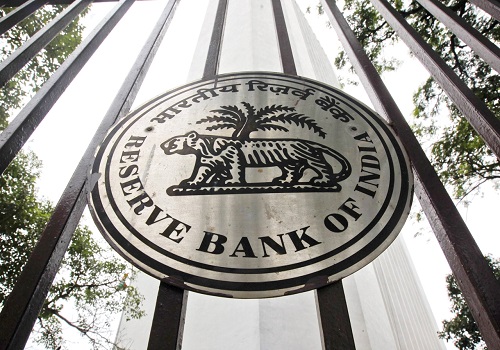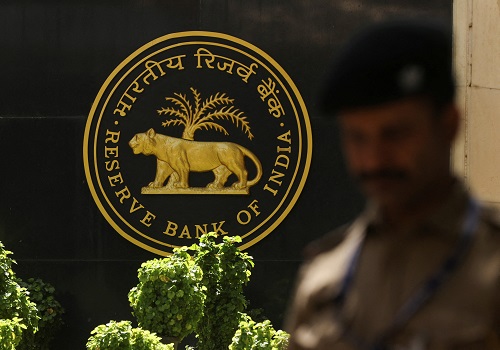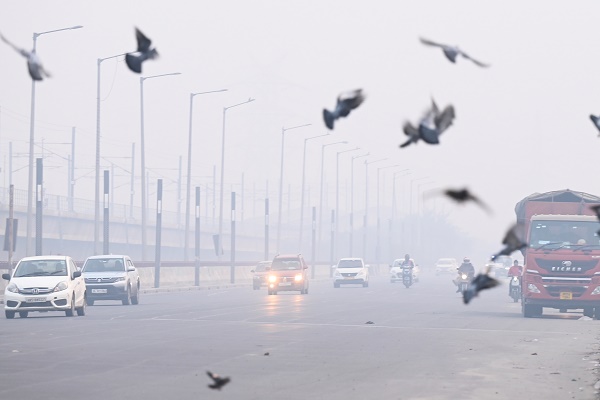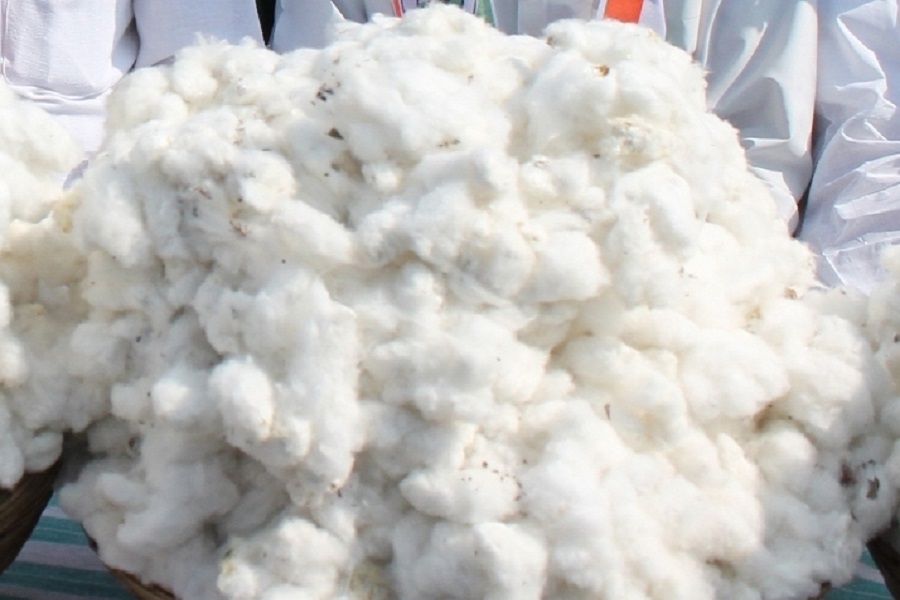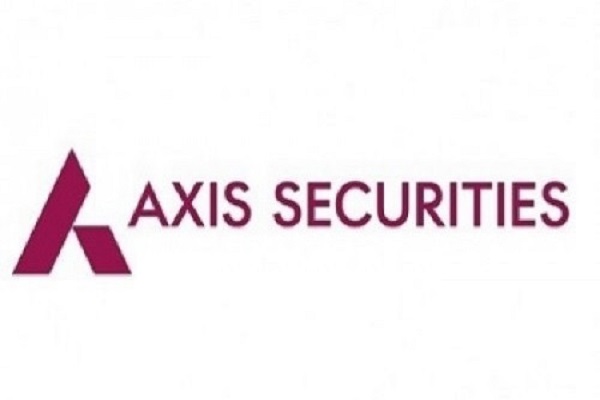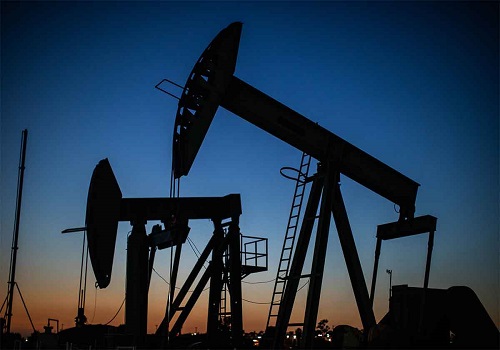Cottoncandy trading range for the day is 54190-54650 - Kedia Advisory

Gold
Gold prices settled down by 0.24% at Rs.85,910 per 10 grams as traders booked profits following a surge to an all-time high. The recent rally was driven by escalating trade war concerns, with U.S. President Donald Trump announcing new tariff threats, including a 25% duty on auto imports and similar levies on semiconductors and pharmaceuticals. Despite the dip, the overall outlook remains strong, with Goldman Sachs raising its year-end 2025 gold price forecast to $3,100 per ounce, citing structurally higher central bank demand as a key driver. Macroeconomic factors also influenced gold prices. The U.S. Producer Price Index (PPI) report provided some relief regarding inflation concerns after a hotter-than-expected consumer price index (CPI) reading. Meanwhile, the London Bullion Market Association (LBMA) reported that gold held in London vaults declined 1.7% to 8,535 metric tons at the end of January, indicating supply constraints. Demand trends show a mixed picture. In India, gold consumption in 2025 is expected to moderate from last year's nine-year high of 802.8 tons, with jewellery demand weakening due to record prices. Indian dealers were forced to offer discounts of up to $26 per ounce. However, investment demand in ETFs, digital gold, and physical bars is expected to remain strong. Technically, the market is witnessing long liquidation, with open interest dropping by 4.9% to 15,824 contracts. Gold has immediate support at Rs.85,650, with a further downside to Rs.85,390. On the upside, resistance is at Rs.86,380, and a breakout could push prices toward Rs.86,850.
Trading Ideas:
* Gold trading range for the day is 85390-86850.
* Gold dropped on profit booking after prices rose to an all time high amid trade war tensions
* U.S. president said he intends to impose auto tariffs "in the neighbourhood of 25%"
* Goldman Sachs raised its gold price forecast to $3,100 per ounce from $2,890 per ounce for end-2025.
Silver
Silver prices settled down by 0.46% at Rs.96,406 as the U.S. dollar remained firm around the 107 level, driven by inflationary concerns stemming from President Donald Trump's tariff threats. The announcement of a potential 25% tariff on auto imports, semiconductors, and pharmaceuticals added to market jitters. Additionally, geopolitical tensions, particularly the U.S. excluding European nations from Russia-Ukraine peace talks, further supported the dollar. Uncertainty around the impact of tariffs on inflation persists among U.S. Federal Reserve officials. While some argue tariffs could disrupt supply chains and increase inflationary pressures, Fed Governor Christopher Waller downplayed the risk of sustained inflation, advocating for a data-driven policy approach. On the supply side, the London Bullion Market Association (LBMA) reported an 8.6% decline in silver held in London vaults to 23,528 metric tons at the end of January - the sharpest drop since records began in 2016. Despite this, global silver supply is projected to rise by 3% in 2025, reaching an 11-year high of 1.05 billion ounces, driven by increased mine production and recycling. The Silver Institute expects a market deficit for the fifth consecutive year in 2025, with industrial demand reaching a record high of over 700 million ounces. Technically, the market remains under long liquidation, with open interest declining by 4.93% to 18,798 contracts. Silver has immediate support at Rs.95,720, with a further downside to Rs.95,040. Resistance is at Rs.97,300, and a breakout above could push prices toward Rs.98,200.
Trading Ideas:
* Silver trading range for the day is 95040-98200.
* Silver dropped as President Donald Trump's escalating tariff threats fueled inflation concerns.
* Fed concerns rise as tariff threats ratchet higher and wider
* Currently, markets are pricing in approximately 35 basis points of easing from the Fed this year.
Crude Oil
Crude oil prices settled up by 0.66% at Rs.6,288, supported by supply disruptions in Russia and the U.S., while the market awaits further clarity on sanctions related to the Ukraine conflict. Drone attacks on Russian oil infrastructure have led to reduced supply, with Caspian Pipeline Consortium (CPC) oil flows dropping by 30-40% due to damage from a Ukrainian strike. This disruption could mean a supply loss of approximately 380,000 barrels per day. In the U.S., extreme cold weather has threatened production, with North Dakota's output expected to decline by 150,000 barrels per day. Additionally, U.S. crude oil imports from Mexico fell to a record low of 149,000 barrels per day, further tightening supply. The latest EIA data showed crude inventories rising by 4.1 million barrels to 427.9 million barrels, exceeding expectations of a 3 million-barrel increase. Gasoline stocks declined by 3 million barrels, while distillate stockpiles saw a modest rise of 0.1 million barrels. Meanwhile, the U.S. Energy Information Administration (EIA) revised its outlook for domestic oil production in 2025, now expecting a higher output of 13.59 million barrels per day. Despite this, global oil demand growth remains weak, and Brent crude prices are projected to average $74 in 2025 before declining to $66 in 2026. Technically, crude oil is experiencing fresh buying, with open interest rising by 23.62% to 3,538 contracts. Immediate support is at Rs.6,249, with further downside potential to Rs.6,211. Resistance is seen at Rs.6,336, and a breakout above this level could push prices toward Rs.6,385.
Trading Ideas:
* Crudeoil trading range for the day is 6211-6385.
* Crude oil prices edged up buoyed by concern over oil supply disruptions in Russia.
* Meanwhile, drone attacks on Russian oil infrastructure are reducing supplies.
* Russia said that CPC oil flows, were reduced by 30-40% after a Ukrainian drone attack on a pumping station.
Natural Gas
Natural gas prices surged by 8.79% to settle at Rs.368.8, driven by extreme cold across parts of the U.S., which boosted heating demand and curtailed production due to freeze-offs in oil and gas wells. Additional support came from record-high gas flows to LNG export plants, reflecting strong export demand. Average U.S. gas output in the Lower 48 states rose to 105.0 billion cubic feet per day (bcfd) in February, up from 102.7 bcfd in January, despite the weather-related disruptions. This also surpassed the previous monthly record of 104.6 bcfd in December 2023. Meteorologists predict colder-than-normal temperatures through February 22, followed by milder conditions until early March. Consequently, natural gas demand is expected to fall from 146.8 bcfd this week to 129.2 bcfd next week. LNG feedgas supply hit a daily record of 16.2 bcfd, surpassing the prior all-time high of 16.0 bcfd, reinforcing the growing export demand. Meanwhile, U.S. utilities withdrew 100 billion cubic feet (bcf) of gas from storage for the week ending February 7, reducing total inventories to 2,297 bcf. This exceeded expectations of a 92 bcf withdrawal, driven by record-high heating demand, with the sharpest declines seen in the Midwest and East regions. Technically, natural gas is experiencing short covering, with open interest dropping by 35.26% to 13,523 contracts. Support is seen at Rs.352, with a further downside target at Rs.335.2. On the upside, resistance is positioned at Rs.378.8, and a breakout above this level could push prices toward Rs.388.8.
Trading Ideas:
* Naturalgas trading range for the day is 335.2-388.8.
* Natural gas jumped as extreme cold and cut output by freezing oil and gas wells.
* Prices also gained support as gas flows to liquefied natural gas (LNG) export plants hit record highs.
* Average gas output in the Lower 48 U.S. states rose to 105.0 billion cubic feet per day (bcfd) so far in February.
Copper
Copper prices remained nearly flat, settling at Rs.868.05, down by a marginal 0.03%. Market sentiment was weighed by US-led efforts to end the Russia-Ukraine war, which raised the possibility of Russian copper re-entering Western markets. Concerns over US tariffs on copper imports eased after President Donald Trump indicated a delayed implementation compared to aluminum and steel tariffs. In China, authorities imposed restrictions on copper smelting to address overcapacity, leading to increased copper imports and declining inventories. However, smelting firms continue to face profitability challenges. Meanwhile, President Xi Jinping reiterated support for the private sector, with the NDRC outlining plans to ease business difficulties, signaling a pro-growth policy stance. On the monetary policy front, PBOC Governor Pan reaffirmed the central bank’s commitment to market-driven exchange rate policies while maintaining stability. On the global supply side, Peru’s copper output in 2024 declined by 0.7% to 2.73 million metric tons, marking the first drop after four years of recovery. The country’s production is expected to stabilize at around 2.8 million metric tons through 2025. Meanwhile, the refined copper market saw a 131,000 metric ton deficit in November, up from a 30,000 metric ton deficit in October, as per the ICSG. Technically, the market is under long liquidation, with open interest declining by 10.54% to 3,743 contracts. Copper is currently supported at Rs.863.3, with further downside potential to Rs.858.4. On the upside, resistance is seen at Rs.874, with a breakout possibly pushing prices towards Rs.879.8.
Trading Ideas:
* Copper trading range for the day is 858.4-879.8.
* Copper dropped amid possibilities that Russian copper could return to the Western market.
* Citi revises down 6 – 12 month copper forecast amid tariff concerns
* Citi revised its copper supply and demand balance, predicting a small deficit of about 136 kilotons in 2025.
Zinc
Zinc prices declined by 0.54%, settling at Rs.268.65, as market sentiment was weighed down by U.S. President Donald Trump's threats to impose 25% tariffs on automobiles, semiconductors, and pharmaceutical imports. Such measures could disrupt global trade and negatively impact zinc demand, particularly in manufacturing and industrial applications. On the supply side, Shanghai Futures Exchange (SHFE) zinc inventories surged by 70.5% from last Friday, reflecting weaker demand in China. Meanwhile, China's central bank signaled further policy adjustments to stimulate economic activity amid external pressures and weak domestic consumption. A record increase in new bank loans in January reinforced expectations of additional stimulus measures. Global zinc production has been declining, with 2024 marking the third consecutive year of contraction. China's refined zinc output fell by 7% in 2024 due to lower processing rates, and production is expected to further decline in early 2025 due to holiday shutdowns and maintenance. Additionally, Alaska’s Red Dog Mine, the world's largest zinc mine, is set to slow production in 2025 as ore reserves are depleted. The global zinc market recorded a deficit of 52,900 metric tons in November, down from 65,400 metric tons in October, according to ILZSG data. Technically, the market is under long liquidation, with open interest dropping by 10.64% to 2,057 contracts. Zinc is currently finding support at Rs.267.1, with a further downside possibility to Rs.265.4. On the upside, resistance is seen at Rs.270.7, and a breakout above could push prices toward Rs.272.6.
Trading Ideas:
* Zinc trading range for the day is 265.4-272.6.
* Zinc eased following U.S. President Trump's threat to impose 25% tariffs on automobiles and semiconductor chips.
* Zinc inventories in warehouses monitored by the Shanghai Futures Exchange rose 70.5% from last Friday
* LME zinc total stocks were at the lowest since February 2024.
Aluminium
Aluminium prices edged up by 0.17%, settling at Rs.262.4, as the European Union agreed to ban Russian primary aluminium imports as part of its 16th sanctions package, set to be phased in over the next year. This geopolitical move could tighten global supply in the long run, although its immediate impact remains uncertain. Additional support came from falling aluminium stocks in LME-registered warehouses, which dropped to 547,950 tons, the lowest since May, with on-warrant stocks decreasing to 227,775 tons after significant cancellations. On the supply side, China’s aluminium production reached a record 44 million tons in 2024, approaching the government-imposed cap of 45 million tons. However, domestic production is expected to rise slowly in February as post-holiday inventory buildup continues. Despite higher production, China’s aluminium industry turned unprofitable for the first time in three years, with producers facing average losses of 687 yuan per ton. Meanwhile, China's exports of unwrought aluminium and aluminium products rose by 17% in the first ten months of 2024, reaching nearly 5.5 million tons. In the U.S., aluminium premiums surged 60% since Donald Trump’s re-election, driven by expectations of increased tariffs and policy changes. Technically, the market is under short covering, with open interest dropping by 19.34% to 1,835 contracts. Aluminium has support at Rs.260.1, with a potential downside to Rs.257.7, while resistance is seen at Rs.265.6, and a move above could push prices toward Rs.268.7.
Trading Ideas:
* Aluminium trading range for the day is 257.7-268.7.
* Aluminium rose as EU envoys agreed to ban Russian primary aluminium imports in their 16th sanctions package.
* The LME aluminium contract has been rising for four consecutive sessions, attracting buying from Commodity Trading Advisors.
* LME daily data which showed that total aluminium stocks in LME-registered warehouses slid to 547,950 tons, their lowest since May
Cottoncandy
Cottoncandy prices edged up by 0.09% to settle at Rs.54,420, supported by lower production estimates for the 2024-25 season. The Cotton Association of India (CAI) projected total cotton output at 301.75 lakh bales, a decline from 327.45 lakh bales in the previous season, due to reduced yields in Gujarat, Punjab, and Haryana. Despite the lower output, the quality of cotton remains strong. As of January 2025, total cotton supply was estimated at 234.26 lakh bales, including fresh pressings of 188.07 lakh bales, imports of 16 lakh bales, and an opening stock of 30.19 lakh bales. Domestic consumption is projected at 315 lakh bales, while exports are expected to drop significantly to 17 lakh bales from 28.36 lakh bales in 2023-24. Globally, Brazil’s cotton production for 2024-25 is expected to rise by 1.6% to 3.76 million tons, with a 4.8% expansion in planting area, ensuring a strong supply outlook. Meanwhile, the U.S. cotton balance sheet saw minimal adjustments, with mill use reduced by 100,000 bales and ending stocks slightly increased. China’s cotton production saw a one-million bale increase, while consumption rose in Bangladesh, Pakistan, and Vietnam, offsetting declines in India and the U.S. Technically, the market is under short covering, with open interest remaining unchanged at 253 contracts. Support is seen at Rs.54,310, with further downside potential to Rs.54,190. On the upside, resistance is likely at Rs.54,540, and a breakout above this could push prices toward Rs.54,650.
Trading Ideas:
* Cottoncandy trading range for the day is 54190-54650.
* Cotton gains as CAI said the overall cotton output is estimated to dip to 301.75 lakh bales due to lower yield in Gujarat.
* CCI is likely to buy more than 100 lakh bales of cotton at MSP during the current cotton year.
* Brazil’s 2024-25 cotton production is projected to be 1.6 per cent higher.
* In Rajkot, a major spot market, the price ended at 25693.1 Rupees gained by 0.03 percent.
Turmeric
Turmeric settled flat by 0.02% at 12,968 as the arrival of the new crop began in key markets like Nizamabad and Hingoli. Despite an increase in acreage to 3.30 lakh hectares this season - 10% higher than the previous year - untimely rains have raised concerns over productivity. Farmers in turmeric-producing regions, especially Nanded, anticipate a 10-15% decline in yield due to smaller rhizomes and some instances of crop rot. As a result, overall production may remain on par with last year’s 10.75 lakh tonnes or fluctuate slightly within a 3-5% range. On the trade front, turmeric exports showed resilience, rising 9.8% year-on-year to 1,21,601.21 tonnes from April to November 2024. However, November exports dropped 20.18% compared to October but surged 48.22% compared to November 2023. Meanwhile, imports surged by 101.8% year-on-year, reaching 18,937.95 tonnes from April to November 2024, although November imports declined slightly by 2.65% compared to the same period last year. In the Nizamabad spot market, turmeric prices rose 0.57% to close at Rs.13,022.9, reflecting steady demand. Technically, the market is witnessing fresh buying, with open interest increasing by 2.11% to settle at 11,860 contracts. Immediate support is seen at 12,844, with further downside levels at 12,718. On the upside, resistance is at 13,062, and a breakout above this could push prices toward 13,154. The market remains watchful of further crop arrivals and confirmation of lower yield estimates.
Trading Ideas:
* Turmeric trading range for the day is 12718-13154.
* Turmeric settled flat as arrival of new turmeric crop has started.
* Turmeric area was recorded as 3.30 lakh hectares, which is 10 percent more than the area of about 3 lakh hectares.
* In Nanded, there is a possibility of a 10 to 15 percent decline in the productivity of turmeric.
* In Nizamabad, a major spot market, the price ended at 13022.9 Rupees gained by 0.57 percent.
Jeera
Jeera settled lower by 1.77% at Rs.21,140 due to sluggish demand and sufficient supply from existing stocks. The arrival of the new cumin crop in Gujarat has been delayed by nearly a month due to unfavorable weather conditions. Sowing was also postponed in major producing states like Gujarat and Rajasthan, leading to concerns about timely availability. Farmers still hold around 20 lakh bags of jeera, with only 3-4 lakh bags expected to be traded by the end of the season, leaving a substantial carry-forward stock of 16 lakh bags. Despite these factors, the current season’s jeera production is expected to remain at similar levels to last year, supported by favorable crop conditions. India’s cumin seed production for 2023-24 has risen to 8.6 lakh tonnes from an area of 11.87 lakh hectares, up from 5.77 lakh tonnes in the previous year. Indian cumin remains the cheapest in the global market, priced at $3,050 per tonne, significantly lower than Chinese cumin, which costs $200-$250 more. Jeera exports surged 74.04% year-on-year to 1,47,006.20 tonnes between April and November 2024, though November exports dropped by 28.92% from October levels. However, compared to November 2023, exports rose by 42.67%. In Unjha, a key spot market, prices declined by 0.16% to Rs.21,481.6. Technically, the market is under fresh selling, with open interest increasing by 1% to settle at 2,730 contracts. Immediate support is at Rs.20,970, with a further downside at Rs.20,810, while resistance is seen at Rs.21,390, and a breakout above this could push prices toward Rs.21,650.
Trading Ideas:
* Jeera trading range for the day is 20810-21650.
* Jeera dropped as demand is low and the current export business is being met from the available stock.
* The start of the new crop of cumin in Gujarat has also been delayed by about a month.
* Due to unfavourable weather, this time the start of sowing of cumin in Gujarat and Rajasthan was delayed by about a month.
* In Unjha, a major spot market, the price ended at 21481.6 Rupees dropped by -0.16 percent.
Views express by all participants are for information & academic purpose only. Kindly read disclaimer before referring below views
